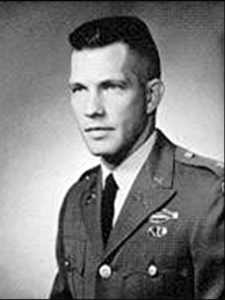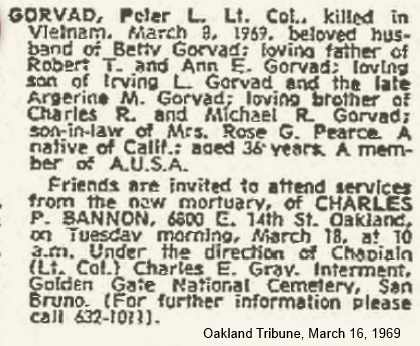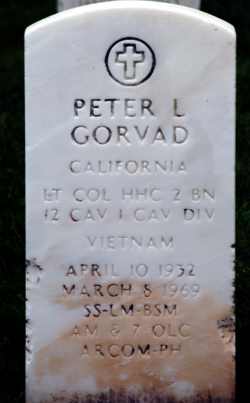| |
|
|
|
Peter Lawrence Gorvad
Lieutenant Colonel
HHC, 2ND BN, 12TH CAVALRY, 1ST CAV DIV, USARV Army of the United States Oakland, California April 10, 1932 to March 08, 1969 PETER L GORVAD is on the Wall at Panel W30, Line 74 See the full profile or name rubbing for Peter Gorvad |

  |

|



| |
June 16, 2014Lieutenant Colonel Gorvad was born in Hollywood, California April 10th, 1932 to Argerine M and Irving T Gorvad. He grew up in southern California and moved to Oakland in 1944, graduating from Castlemont High School in 1949. He enrolled at San Jose State University in the fall of 1949, pursuing a degree in Police Science. While studying at San Jose State, Lieutenant Colonel Gorvad enrolled in the Military Police Corps (MPC) Reserve Officer Training Corps (ROTC) program and received his first exposure to military life. This first exposure would mark the beginning of a lifetime devoted to the army and the service of his country. Upon graduation from university in 1953 as the Top Graduate in the Police program he was offered and accepted a Regular Army commission with the Infantry Branch. Lieutenant Colonel Gorvad rose quickly from Lieutenant to Lieutenant Colonel in just fourteen years. After completing the Infantry Officer Basic Course in 1953, he was assigned to the 20th Regiment and the 63rd Regiment of the 6th Infantry Division at Fort Ord, California where he was responsible for training recruits. In 1955 he was assigned to the 39th Infantry Regiment in Nuremburg, Germany where he served as a Platoon Leader, Company Executive Officer and Assistant Regimental Operations Officer. With the implementation of the Pentomic Division across the US Army, he was assigned to Brannburg serving with the 5th, 8th and 29th Infantry Battlegroups for short periods in various command and staff positions before returning to the Continental United States (CONUS). Upon his return to CONUS, Lieutenant Colonel Gorvad served at the US Army Infantry School in Fort Benning where he was a Company Commander, then in 1958, he completed the Infantry Officer Advanced Course and in 1959 he successfully completed Ranger School and Airborne training completing the most challenging training the infantry had to offer. From 1961 to 1962 Lieutenant Colonel Gorvad served in Korea. He was an Assistant Brigade Operations Officer in the 7th Infantry Division and then became the Post Adjutant at Camp K6 (later named Camp Humphrey). Next he was assigned to Fort Bragg, first completing the Special Warfare Officer's Course), next serving as the Secretary of the Special Warfare School, and finally, with the 5th Special Forces Group. After finishing operations in South America, LTC Gorvad was promoted to Major and assigned to the 5th Special Forces Group. As the Commander of Detachment B5/410, headquartered at Can Tho, South Vietnam, he served from late 1963 to the summer of 1964, responsible for six operational A Detachments, conducting operations throughout the Mekong Delta. Among his A Detachment Commanders were Special Forces legend, Larry Thorne and Medal of Honor winner Lee Mize. As a result of his success as a commander in counter-insurgency operations during Special Forces infancy, he briefed senior officers at the Pentagon upon his return. His observations and recommendations would shape the nature of the deployment of Special Forces to South East Asia for the remainder of the conflict. Before leaving the 5th Special Forces Group, Lieutenant Colonel Gorvad served as C Detachment Commander and made every effort to impart his knowledge of the nature of warfare in Vietnam on departing Special Forces Detachments. After completing the 'long course' and specializing in counter-insurgency at the Command and General Staff College at Fort Leavenworth in 1965, Lieutenant Colonel Gorvad was assigned to Camp Borden as the US Exchange Officer at the Tactics and Doctrine Division of the Combat Arms School. After his three-year tour at the school, he was faced with the decision of being assigned to the Pentagon and attending National War College or returning to Vietnam as a Battalion Commander. He chose Vietnam. LTC Gorvad was assigned to the 3rd Brigade "Garry Owen" of the 1st Cavalry Division as the Executive Officer on August 27th, 1968. In this position, he was instrumental in organizing the 571 mile move of the brigade by air, land and sea during Operation LIBERTY CANYON in October 1968 and organizing a major base complex at Quan Loi that allowed the brigade to commence operations there. In January 1969, he assumed command of the 2/12th Cavalry at LZ GRANT, Tay Ninh Province. In February and March, his battalion was responsible for interdicting the main enemy supply route in War Zone 'C' from Cambodia. The 2/12th Cavalry was highly successful in locating caches of rice, weapons and ammunition. As a result of the interdiction operations, LZ GRANT was under constant attack from the NVA 95C regiment. The base was originally an old French position and a concrete bunker was still standing. The NVA had also visited Grant, leaving behind booby traps and mines for the next unit to occupy the position. Two companies immediately went into the jungle to find and interdict the NVA supply route and one stayed behind to improve the defensive positions and protect the Headquarters element and the artillery. Three attacks were fought for LZ Grant. They tested the mettle of a unit and they set a standard for men to meet in the defense of their unit. On 23 February 1969, the first somewhat heavier attack occurred by the 95th NVA Regiment and a sapper company. On 8 March they were again attacked, this time by an even larger NVA/VC force. The attack ended with over 150 enemy dead in the perimeter wire. The last major attack came on 12 March when they were hit by the largest ground force of NVA and VC plus sappers. None of these attacks were as fierce as the attack launched in the early hours of 8 March 1969. It was shortly after midnight. The men in the TOC (Tactical Operations Center) and all the men on the base were on 100 percent alert, as it had been for the past several days while North Vietnamese gunners hurled mortar shells and rockets at its perimeter. All intelligence indicated that the area around GRANT was increasing the number of North Vietnamese troops; massing for an attack. As usual, the attack began with rockets and mortars, followed by a ground attack. During the fighting, a 122mm rocket with a delay fuse directly landed on top of the sandbagged TOC; the big projectile sliced through three layers of sandbags and detonated inside ... Major Billy Brown, the battalion operations officer, had been outside the TOC checking on the readiness of the base defense when the rocket hit. He raced back to the TOC and found it demolished. When he looked through the smoke and dust, he could see LTC Gorvad, dead in his chair at the map board, just where Major Brown had left him earlier. The unit was successful in defending GRANT, but the death of LTC Grant was felt by all ranks in the battalion and the division. For his conduct during the action, Lieutenant Colonel Gorvad was awarded the Silver Star, which read in part: "When his unit's perimeter came under intense, rocket, mortar and ground attack, Lieutenant Colonel Gorvad exposed himself to the hostile barrage as he left the relative safety of his command bunker and moved to the perimeter where he adjusted air strikes and aerial rocket artillery on the advancing insurgents. With complete disregard for his own personal safety, he moved from position to position, directing the base of fire from his men. At this point, he returned to the command bunker and continued to direct the defense until a rocket hit the bunker and he was mortally wounded." Following his death the 1st Cavalry Division's Base Camp at Phuoc Vinh was named in his honor; later when the Division Headquarters moved, Camp Gorvad became the headquarters for the 1st Cavalry's Division Artillery. Furthermore, a street was named after Colonel Gorvad at Camp Humphrey, South Korea in 1975. and the Canadians, too, would honor the lost warrior. Canada named their Canadian Forces Base (CFB) Borden's Drop Zone, as Drop Zone Gorvad. The base, is located in Ontario and is the historic birthplace of the Royal Canadian Air Force. CFB Borden is the largest training facility in the Canadian Forces. You can read more about CFB Borden and LTC Gorvad here. The 14 men from the 1st Cavalry Division killed in action on March 8 were:
LTC Peter Lawrence Gorvad is buried in Golden Gate National Cemetery, San Bruno, California. He was survived by his wife, Betty A Gorvad, a daughter Ann E and one son, Robert T, all from San Leandro, California. His son, Robert T, upon his death in 1975, was buried with LTC Gorvad. He was also survived by his father, Irving L. Gorvad, San Pablo, California. Below is the funeral notice for LTC Gorvad. 

- - The Virtual Wall, June 10, 2014
|
| Contact Us | © Copyright 1997-2019 www.VirtualWall.org, Ltd ®(TM) | Last update 08/15/2019 |